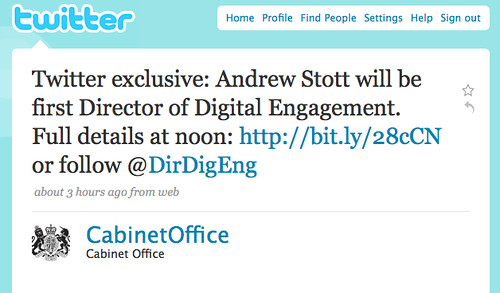This has come from Vicky Sargeant at the Socitm press office and I offer it to you verbatim simply because I don’t have time to fully digest it and add links just now, there doesn’t seem to be a apge to link too, but I don’t want to forget to share it with you:
News Release:
County Councils saw their web traffic double last Friday and Saturday thanks to their provision of a sophisticated online election results service coupled with use of social media tolls like Twitter, Facebook, RSS feeds and email alerts.
Figures from the Socitm Website Takeup service, subscribed to by more than half of all county councils show that on Friday 5th and Saturday 6th June, web traffic to county council websites was more than double that of the Friday and Saturday of the previous week.
This trend is bourne out by results from individual councils like Derbyshire, which last Friday saw the highest ever number of visits to its website in one day including more than 19,000 visits to its election section alone.
The sophistication of the election results coverage by councils through their websites has been captured through a survey by Socitm Insight, publishers of the annual Better connected report on council website quality. The survey looked at websites of county councils and new unitaries where elections had been held to see how the results were being reported. It followed a similar exercise carried out at the last county elections in May 2005.
The survey found that almost all councils were reporting results on their websites ‘live’ or as near to real-time as possible and were carrying very prominent links and features on the home page. Many included some form of interactive map, summary tables and charts or other graphics to allow visitors to follow the results as they happened and to access a summary in various forms. Some councils provided TV style graphics including ‘virtual council chambers’ filling up with figures in party colours as the results came in.
A few councils provided a live online comparison with previous election results, showing whether seats were being held, lost or gained. A number of councils stated when the count was due to start, but even better were councils who offered an estimate as to what time the first result was likely to be expected.
Nine councils were also promoting their use of RSS feeds and / or Twitter to publish the results, using these opportunities for to enhance their interaction with the public through these new channels. During the results period, fans on Derbyshire’s Facebook page rose from 22 to 73 and their Twitter account followers rose from 122 to 335. Derbyshire’s Facebook ‘fans’ were contributing comments, and responding to one another as the day unfolded. One said ‘Local newspaper site reporting recounts in Long Eaton while Twitter and @derbyshirecc knows its over. SO behind. V. poor compared to you guys. Many thanks for all the hard work pulling this together today’.
Other innovations noted on election pages included:
- Norfolk County Council – featured its YouTube video on why you should vote
- Lancashire County Council – offered the facility to subscribe to receive results by e-mail
- North Yorkshire County Council – featured a video about how the democratic process works
Surrey County Council – charts included a summary of holds and a swing chart
‘Our survey provides evidence of the opportunity local councils now have to use their website and social media tools to engage with and inform local people as never before’, says Martin Greenwood, Programme Director for Socitm Insight. ‘Councils are no longer dependent on traditional media to communicate their messages and can outperform them anyway as a source of immediate, authoritative and totally up to date information – we have seen this with local emergencies like flooding, and now with elections. Councils should be seizing this new opportunity with both hands.’
More Socitm news here.

